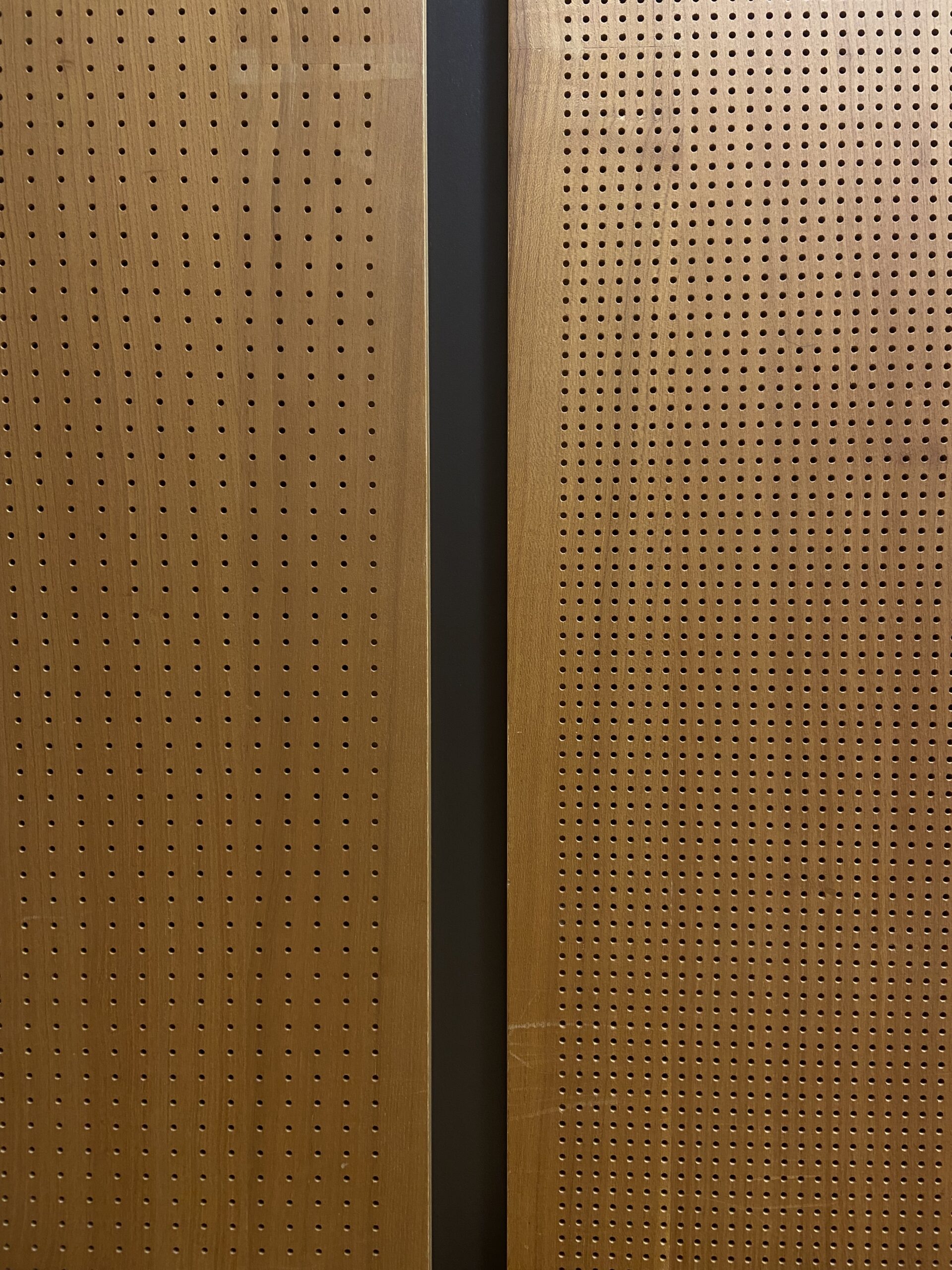Chosen space: HIL E3

Exploring Sound Qualities in Architectural Design
A space specially created to hold extended lecture periods. The space is designed so that the professor at the front facing the students can clearly perceive everything inside the room.
The other way around the person speaking at the front represents the starting point from which the entire room opens up. One can directly perceive the entire geometry of the room as a way to materialize the form of the waves travelling starting at the front.
One of the interesting features of this space is that you can literally feel the broad spaciousness inside of it. You don’t really feel any reverberations as the walls and even the tables are designed to absorb giving the impression of something flowing into and being lost in the wide sea.
We have noticed that it really depends on who is holding the lesson at the front. Depending on the frequency of the person’s voice, it has an impact on intelligibility. Some voices reach a level that is easily audible on their own and, therefore, do not need a microphone at all.
Acoustic slang terminology:
- Open
- Diffuse
- Clear
Exploring the Emotional Impact of Everyday Sounds
We consider the sound quality to be “good”. The person standing at the front can be heard clearly and distinctly, even in the last rows. And if they speak loudly and clearly enough, they can also be heard without a microphone.
Before a lecture, students swarm to the fixed seats. There is a rustling in the room, zips are opened, jackets are taken off with swishes, and the wooden table elements are pushed into position. All these noises combine to create a soundscape of settling in. After many have plugged in their charging cables to their laptops with a click, silence slowly falls. At the same time, you can hear constant talking noises. The gong glings and the lesson starts. Many are still looking for the last items in their backpacks – and it is precisely these individual noises that now come to the foreground. These are then picked up directly by your own attention, you get distracted.
In the lecture hall, you are cut off from your surroundings and the outside world. You would be alarmed if you suddenly heard unfamiliar noises from outside, as this is not normally the case. This happens for example when people enter the lecture foreroom-zone and talk to each other, or arrive late and make their way up to their seat.
What you don’t notice at first is the continuous sound of the ventilation in the background as a low, constant hiss. Once you hear it, you realise that it’s not so quiet after all, and it is difficult to get it out of your focus.
Empirical and numerical estimation of room acoustic properties.
The HIL E3 is a lecture hall with 256 fixed seats, a tiered shape, a floor area of 301 m2 and a height of about 5m. The volume is about 1200 m3.
materials: carpet floor, absorbent wooden panels on the walls and a zig-zag ceiling, wooden furniture.
clap:
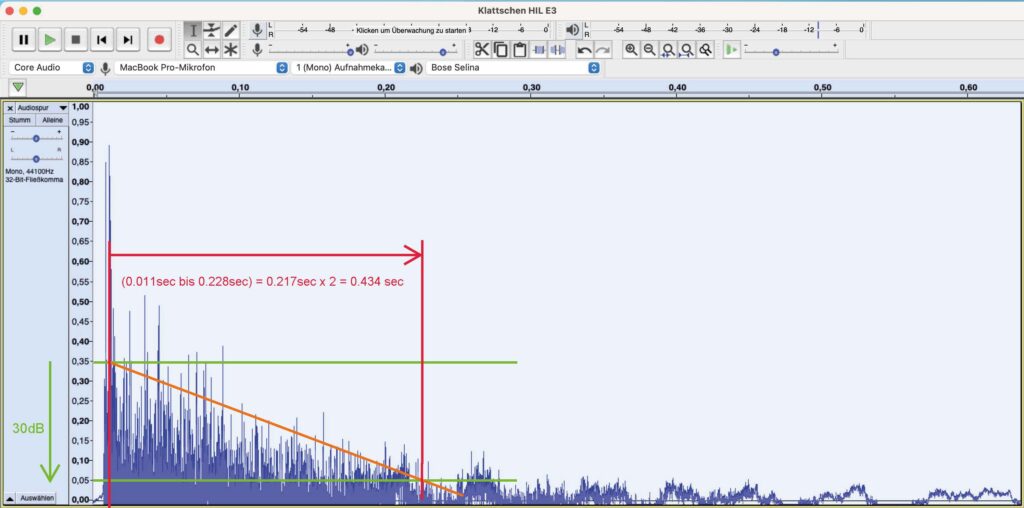

RT60 = 0.217 sec x 2 = 0.434 sec
This reverberation time is quite good for a room of this size. It is influenced by numerous acoustic elements.
Characterization of room acoustic treatments

Lecture hall E3 has a number of acoustic components. The ceiling features prominent zigzag elements. These not only act as lighting, they as well diffuse sound. There is also a carpeted floor and the walls are clad with wooden elements, which in the back of the hall feature perforated holes, which both also have absorbent effects.
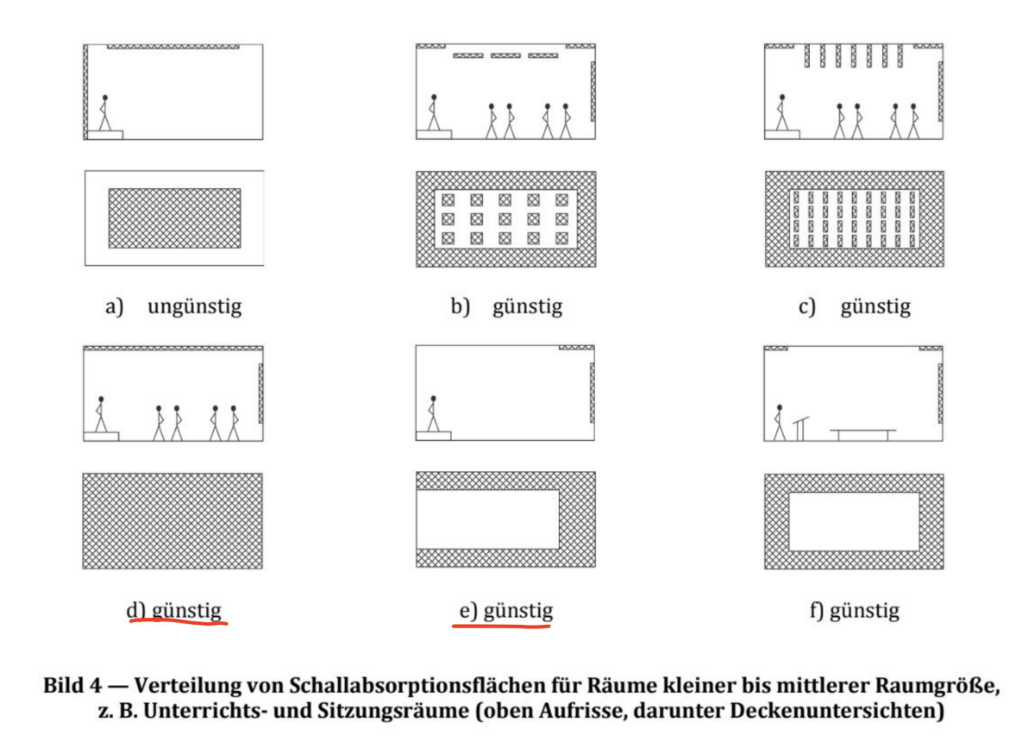
The shape of the room is increased in height from the front (where the lecturer stands) up to the last rows of chairs. This improves visibility right up to the front and may also have acoustic advantages. The chairs and tables are objects with many irregular surfaces, which also diffuse sound. It also makes a difference whether the room is empty or completely filled with people: They are wearing clothes that absorb and generate even more surfaces themselves.

Sound making – Sound walking
Chosen object: zipper on a case for cables and other items used at the start by students in lectures.
Part 1:
It is a round hollow case, made out of a hard-plastic fabric, which can store multiple items. The zipper produces a zip sound when you want to get access to your items. During the act of opening the case, a whirr occurs. At the end, you hear a snap when you snap the slider onto the bottom stop.
The HIL E3 is a space specially created to hold extended lecture periods. The space is designed so that the professor at the front facing the students can perceive everything inside the room.
Part 2:
Soundwalk
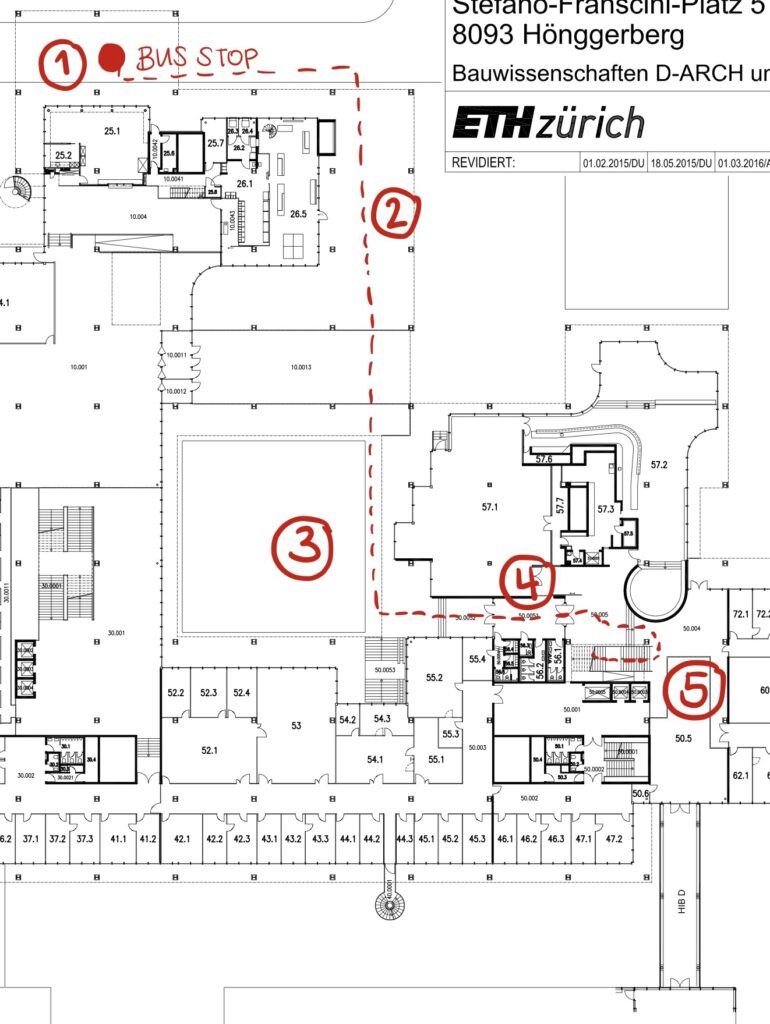
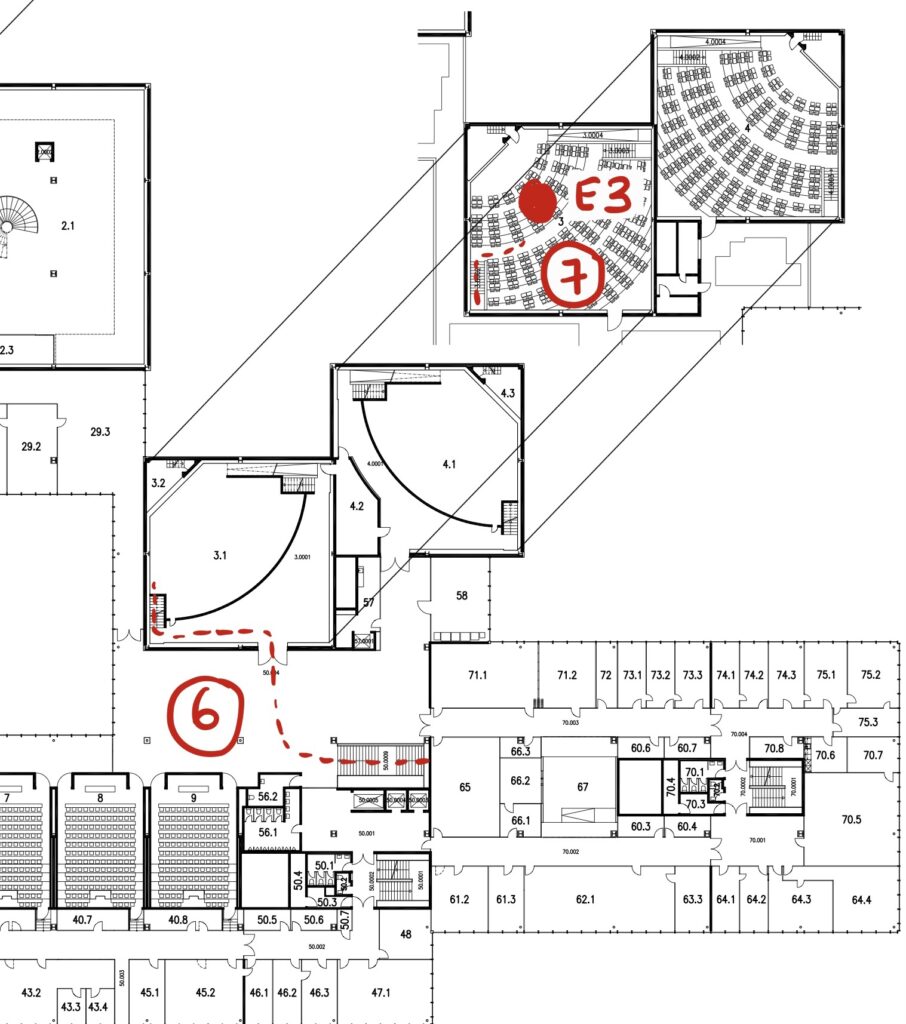
- The Bus Stop – outdoor
- Covered Space – outdoor
- Courtyard – outdoor
- “Windfang” HIL – indoor
- GTA-Foyer – indoor
- Front of E3 – indoor
- Lecture Hall E3 – indoor
outdoor: It is 7.30 pm on Wednesday evening. The soundwalk starts at the bus station ETH Hönggerberg, where a bus just arrived – it whirrs and opens the door. In the background, the constant rushing sounds of the streets are heard diffusing to sides.
As we continue towards HIL, we enter the space under its massive cubic volume. We hear the road noise fade into the background originating from farther aways. The sounds of footsteps on the stone floor are only heard briefly in the spacious, covered outdoor area. We can hear the steps sharply accelerating at the sealing into sizzling before smoothing out. Boxes cover the entirety of it with a little distance between from where the sizzles are produced. On our right, the automatic door to the main entrance opens with a loud clack and queeeck. However, we walk past the planted inner courtyard and turn left. There are exhaust fans that blow out the air with a loud whoosh. You can hear the light wind blowing over and under the HIL. Now stepping up to the left entrance via stairs, we enter the “Windfang”.
indoor: You can already hear the voice from the alumni lounge over the microphone – it’s beer bingo night. The hissing background noises from outside have disappeared. The sounds of footsteps are brighter, higher and precisely emphasised. The GTA foyer is atmospherically set to soft music, inviting you to sit down on the armchairs. However, we walk straight past it and take the stairs up to the E-floor with squeaky steps in our still slightly wet shoes. Up here, you are all alone – there are no people. The steps are now the focus of the noisy atmosphere. Unfortunately, the E3 is already closed. Shit. I’ll just have to pick up my forgotten case tomorrow.
Norms
A space specially created to hold extended lecture periods. The space is designed so that the professor at the front facing the students can clearly perceive everything inside the room.
DIN 18041:
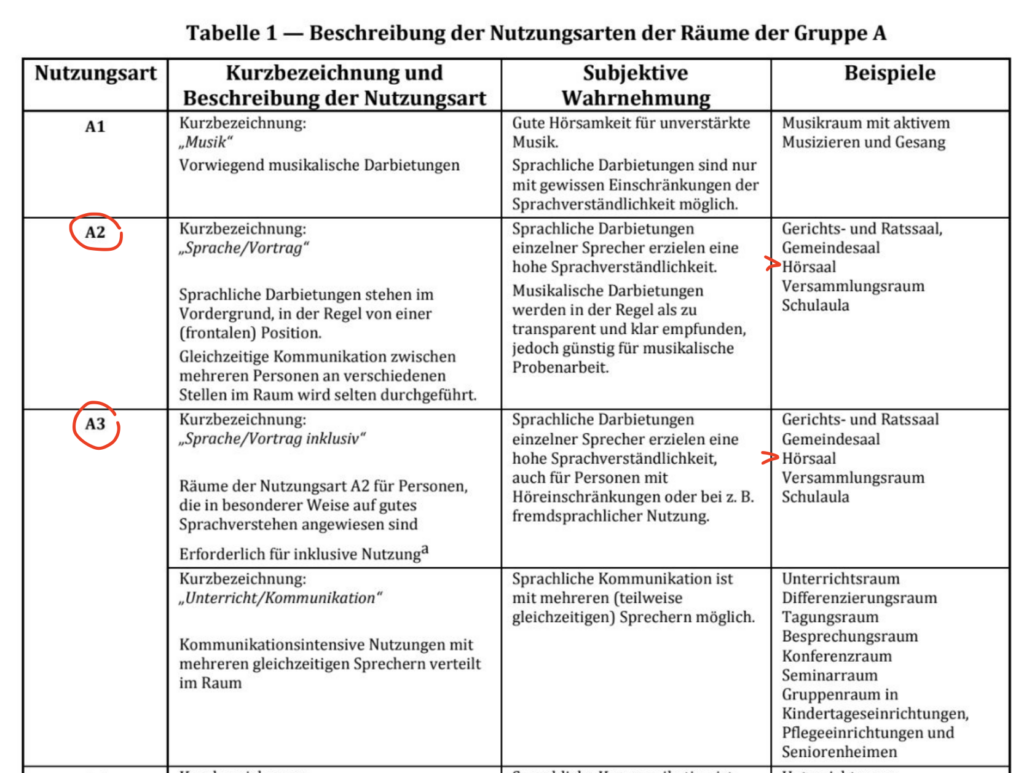

V = 1200 m3 (estimated)
A2: Tsoll,A2=(0.37*log(V/m3)-0.14)*s = 1.0 s > 0.434 s
A3: Tsoll,A3=(0.32*log(V/m3)-0.17)*s = 0.8 s > 0.434 s

We got a reverberation time lower as calculated by the norm DIN 18041.

